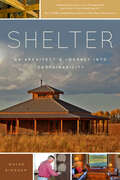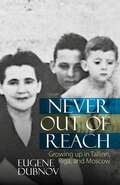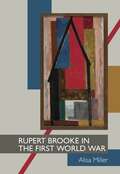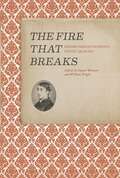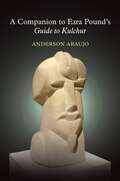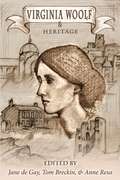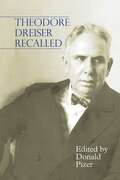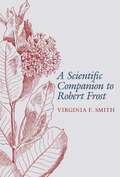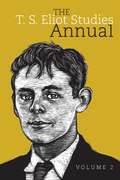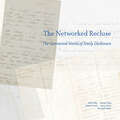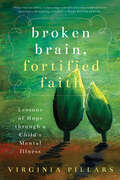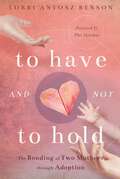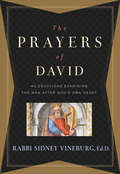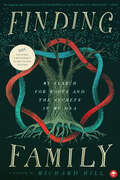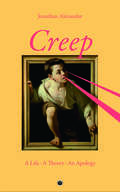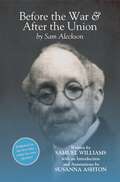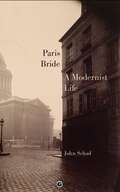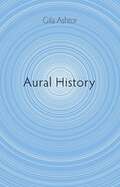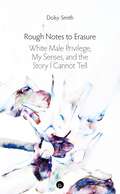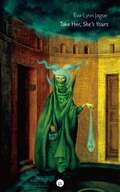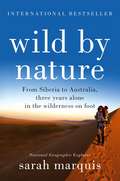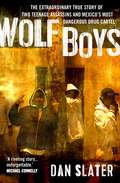- Table View
- List View
Shelter: An Architect's Journey into Sustainability
by Wayne BinghamAfter being trained and practicing conventional glass, steel, and concrete architecture for thirty years, an award-winning architect discovers the concept of sustainable living and embarks on a journey that ends with his own strawbale home at the foot of the Grand Tetons.
Never Out of Reach: Growing up in Tallinn, Riga, and Moscow
by Eugene DubnovThis memoir, a young poet’s tragicomic account of crossed loves and rebellions as he grows from boy to man under the vigilant eyes of the state in the Soviet Union between the 1950s and 1970s, can be approached as a bildungsroman. It is set in Tallinn, Riga and Moscow (with episodes in Uzbekistan, Moldavia, and the Ukraine) and, apart from this author’s own story, deals with the experiences of young people of that period, their friendships and attempts to form erotic/romantic attachments, as well as their search for national—Baltic, Jewish, Russian—identity while being watched and sometimes interrogated by the secret police. It also includes some reconstruction of the author’s family history: expulsion from Spain, the Magician of Prague, the renowned historian Simon Dubnov. The volume progresses from the demonstration of two seven-year-old boys’ against Stalin and Lenin, in Tallinn, in the mid-1950s to a dramatic and doomed love affair with a woman married to an army colonel who attempts to shoot the author as the latter is about to make his final exit from the country, with the KGB on his tail, in the early 1970s. While raising a number of important historical and contemporary issues, the memoir is also an involving narrative, a visually descriptive story, varied and engrossing, involving philosophical, theological, and detective elements; popular and literary culture; countries and languages; high seriousness and undercutting irony.
Rupert Brooke in the First World War (Clemson University Press)
by Alisa MillerRupert Brooke died in April 1915, on the eve of the Gallipoli landings. During the First World War Brooke was the iconic poet-soldier, adored and mimicked by readers and would-be writers—both in and out of uniform—with an international following that has neither been examined nor explained since. The general shift in attitudes toward war and the manner in which the war poets are presented meant that Brooke was recast as the exemplar of pre-war innocence, forever swimming in faintly saccharine, nakedly patriotic streams born of his famous poems. Rupert Brooke in the First World War takes a celebrity of the war who became an idol for fellow writers, politicians, literary elites and the general public, and tells the story of his life and famously romantic death, providing readers a fuller sense not only of the human being and his singular life and circumstances, but also of the world he inhabited, and the passions and tastes of men and women living through a period of great upheaval.
The Fire that Breaks: Gerard Manley Hopkins’s Poetic Legacies (Clemson University Press)
by Daniel Westover Thomas Alan HolmesThe Fire that Breaks traces Gerard Manley Hopkins’s continuing and pervasive influence among writers of the twentieth and twenty-first centuries. Not only do the essays explore responses to Hopkins by individual writers—including, among others, Virginia Woolf, T. S. Eliot, Elizabeth Bishop, Seamus Heaney, Geoffrey Hill, and Charles Wright—but they also examine Hopkins’s substantial influence among Caribbean poets, Appalachian writers, and contemporary poets whose work lies at the intersection of ecopoetry and theology. Combining essays by the world’s leading Hopkins scholars with essays by scholars from diverse fields, the essays examine both known and unexpected affinities, and The Fire that Breaks is a persistent testimony to the lasting, continuing impact of Hopkins on poetry in English.
A Companion to Ezra Pound's Guide to Kulchur (Clemson University Press: The Ezra Pound Center for Literature Book Series #2)
by Anderson AraujoPublished in 1938, Guide to Kulchur encapsulates Ezra Pound’s chief concerns: his cultural, historiographic, philosophical, and epistemological theories; his aesthetics and poetics; and his economic and political thought. In its fifty-eight chapters and postscript, it constitutes an interdisciplinary and transhistorical cultural anthropology that exemplifies his slogan for the renovation of ancient wisdom for current use—“ Make It New.” Though wildly encyclopedic, allusive and recursive, Guide to Kulchur is inescapable in any serious study of Pound. A Companion to Ezra Pound’s Guide to Kulchur addresses the formidable interpretive challenges his most far-reaching prose tract presents to the reader. Providing page-by-page glosses on key terms and passages in Guide, the Companion also situates Pound’s allusions and references in relation to other texts in his vast body of work, especially The Cantos. Striking a balance between rigorous scholarly standards and readerly accessibility, the bookis designed to meet the needs of the specialist while keeping the critical apparatus unobtrusive so as also to appeal to students and the general public. A long-needed resource, A Companion to Ezra Pound’s Guide to Kulchur makes a lasting contribution to thestudy of one of the most influential and controversial literary figures of the twentieth century.
Virginia Woolf and Heritage (Clemson University Press)
by Jane DeGay Tom Breckin Anne ReusThis volume aims to situate Virginia Woolf as a writer who, despite her fame as a leading modernist, also drew on a rich literary and cultural heritage. The chapters in this volume explore the role her family heritage, literary tradition and heritage locations play in Woolf’ s works, uncovering the influence the past had on her work, and particularly her deep indebtedness to the Victorian period in the process. It looks at how she reimagined heritage, including her queer readings of the past. This volume also aims to examine Woolf’ s own literary legacy: with essays examining her reception in Romania, Poland and France and her impact on contemporary writers like Alice Munro and Lidia Yuknavitch. Lastly, Woolf’ s standing in the increasingly popular field of biofiction is explored. The collection features an extended chapter on Virginia Woolf’ s relationship with her cousin H.A.L. Fisher by David Bradshaw, and an extended chapter by Laura Marcus on Woolf and the concept of shame.
Theodore Dreiser Recalled (Clemson University Press)
by Donald PizerTheodore Dreiser (1871–1946) has long been recognized as a pivotal figure in twentieth-century American literary and cultural history. His fiction played (and still plays) a major role in the vigorous debate over the relationship of art to social reality and political purpose, and his complex and compelling personality has always attracted much attention. From about 1912–15 to his death he was often considered the greatest American writer of the period. Theodore Dreiser Recalled collects for the first time commentary on this literary giant by those of his own time who knew him well. The book includes seventy-six recollections by friends, lovers, and literary associates, ranging in time of publication from 1912 to 1995. Presented with both expert and general readers in mind, the book not only clarifies and extends our knowledge of many aspects of Dreiser’s life and career but also makes excellent reading. In their various ways—from H. L. Mencken’s acerbic accounts of their friendship to one of Edgar Lee Masters’s most powerful poems to Kirah Markham’s bittersweet memories of their affair and to Esther McCoy’s compelling narrative of Dreiser’s death—the recollections demonstrate Dreiser’s ability to move others to recall him not only in full detail but with panache.
A Scientific Companion to Robert Frost (Clemson University Press)
by Virginia SmithMention Robert Frost and people instantly think of snowy woods and less-traveled paths and rural neighbors meeting to fix their stone fence. But what does Robert Frost have to do with science? You might be surprised. Born in 1874, Frost lived through a remarkable period of scientific progress, including the development of quantum mechanics and the theory of relativity, the Big Bang theory, the discovery of the structure of DNA and the beginnings of space travel. Possessing a powerful intellect driven by keen curiosity, Frost was highly knowledgeable about the science of his time and infuses his poetry with imagery and language borrowed from science. Frost not only uses the language of science to enrich his poetry in the same way he uses classical, historical, biblical and literary allusions, but he also uses ordinary language to create sophisticated metaphors based on scientific concepts such as evolution and entropy. A Scientific Companion to Robert Frost represents the first systematic attempt to catalogue and explain all of the references to science and natural history in Frost’s poetry. The book, which is organized chronologically, uses language that is accessible to laymen and is supplemented by numerous illustrations, and appendices that should make it a valuable resource for teachers and scholars.
The T. S. Eliot Studies Annual: Volume 2 (Clemson University Press)
The T. S. Eliot Studies Annual strives to be the leading venue for the critical reassessment of Eliot’s life and work in light of the ongoing publication of his letters, critical volumes of his complete prose, the new edition of his complete poems, and the forthcoming critical edition of his plays. All critical approaches are welcome, as are essays pertaining to any aspect of Eliot’s work as a poet, critic, playwright, editor, or foremost exemplar of literary modernism. John D. Morgenstern, General Editor Editorial Advisory Board: Ronald Bush, University of Oxford David E. Chinitz, Loyola University Chicago Anthony Cuda, University of North Carolina–Greensboro Robert Crawford, University of St Andrews Frances Dickey, University of Missouri John Haffenden, University of Sheffield Benjamin G. Lockerd, Grand Valley State University Gail McDonald, Goldsmiths, University of London Gabrielle McIntire, Queen’s University Jahan Ramazani, University of Virginia Christopher Ricks, Boston University Ronald Schuchard, Emory University Vincent Sherry, Washington University at St. Louis
T. S. Eliot and Organicism (Clemson University Press)
by Jeremy DiaperT. S. Eliot and Organicism provides the first comprehensive account of Eliot’s preoccupation with agrarianism, organicism and the environment. Jeremy Diaper elucidates and contextualizes several facets of Eliot’s organic thinking, ranging from composting and soil fertility, to regionalism, nutrition and culinary skills. Through detailed examination of Eliot’s engagement with organic issues, this book offers environmental readings of Eliot’s poetry and plays and demonstrates that agrarian concerns emerge as a notable theme in his literary output – from his earliest notebook of poems known as Inventions of the March Hare to Murder in the Cathedral. This book also analyzes Eliot’s prose to illuminate his engagement with the key environmental debates which were taking place during the 1930s-50s. Diaper offers a thorough analysis of Eliot’s social criticism and explores his perturbation regarding the decline of agriculture in After Strange Gods, The Idea of a Christian Society and Notes Towards the Definition of Culture. T. S. Eliot and Organicism breaks new ground by demonstrating that a thorough understanding of Eliot’s engagement with environmentalism is vital to our interpretation of both his poetry and prose. It establishes that one of the twentieth century’s most eminent literary figures should be remembered for his important role in the emergence of the organic husbandry movement and for his wide-ranging comments on a variety of environmental and organic issues.
The Networked Recluse: The Connected World of Emily Dickinson
by Michael Kelly Marta L. Werner Carolyn Vega Susan Howe Richard WilburThe image is so well known it is practically iconic: The reclusive poet, feminine and fragile, weaving verse of beguiling complexity from the room in which she kept herself sequestered from the world. The Belle of Amherst, the distinctive American voice, the singer of the soul’s mysteries: Emily Dickinson. Yet that image scarcely captures the fullness and vitality of Dickinson’s life, most notably her many connections—to family, to friends, to correspondents, to the literary tastemakers of her day, even to the unnamed, and perhaps unknowable, “Master” to whom she addressed three of her most breathtaking works of prose. Through an exploration of a relatively small group of items from Dickinson’s vast literary remains, this volume—an accompaniment to an exhibition on Dickinson mounted at The Morgan Library & Museum in New York—demonstrates the complex ways in which these often humble objects came into conversation with other people, places, and events in the poet’s life. Seeing the network of connections and influences that shaped Dickinson’s life presents us with a different understanding of this most enigmatic yet elegiac poet in American letters, and allows us more fully to appreciate both her uniqueness and her humanity. The materials collected here make clear that the story of Dickinson’s manuscripts, her life, and her work is still unfolding. While the image of Dickinson as the reclusive poet dressed only in white remains a popular myth, details of Dickinson’s life continue to emerge. Several items included both in the exhibit and in this volume were not known to exist until the present century. The scrap of biographical intelligence recorded by Sarah Tuthill in a Mount Holyoke catalogue, or the concern about Dickinson’s salvation expressed by Abby Wood in a private letter to Abiah Root, were acquired by Amherst College in the last fifteen years. What additional pieces of evidence remain to be uncovered and identified in the attics and basements of New England? Published to accompany The Morgan Library & Museum’s pathbreaking exhibit I’m Nobody! Who are You? The Life and Poetry of Emily Dickinson—part of a series of exhibits at the Morgan celebrating and exploring the creative lives of significant women authors—The Networked Recluse offers the reader an account of the exhibit itself, together with a series of contributions by curators, scholars of Dickinson, and poets whose own work her words have influenced.
Broken Brain, Fortified Faith: Lessons of Hope Through a Child's Mental Illness
by Virginia PillarsBroken Brain, Fortified Faith: Lessons of Hope through a Child's Mental Illness shares one mother’s struggles, anger, frustrations as she charges into the world of mental illness, searching for answers to her daughter’s schizophrenia.
To Have and Not to Hold: The Bonding of Two Mothers through Adoption
by Lorri Antosz BensonLorri Benson's memoir To Have and Not to Hold recounts the miracle that occurs when the daughter she gave up for adoption asks to reconnect 16 years later.
The Prayers of David: 40 Devotions Examining The Man After God's Own Heart
by Rabbi Dr. Sidney VineburgDavid was a man after God's own heart, not because he was perfect, but because he always sought God through prayer. It is through his example we can learn to pray in all things at all times. The Prayers of David combines faithful scholarship with accessible writing to bring a personal level of reflection to these emotionally powerful prayers. Cross references and cultural and historical content bring a richer understanding of the Old Testament, while powerful inspirational writing inspires you to model your own prayer life after David's example.
Finding Family: My Search for Roots and the Secrets in My DNA
by Richard HillEasy to read and hard to put down, Finding Family is the first book to chronicle the paradigm-shifting application of genetic genealogy to adoption search. Whether you're searching for your own roots or just craving a darn good read, Finding Family is a book you will likely devour in one sitting . . . and wholeheartedly recommend to others.
Creep: A Life, A Theory, An Apology (PDF)
by Jonathan AlexanderCreeps surround us, seemingly everywhere. People creep up on each other both on the streets and online, with digital technologies vectoring a lot of cyber-stalking. It’s so easy to spy on people that “creep catching” has even become a form of news entertainment in shows such as “To Catch a Predator.” But what defines a creep is so broad that nearly anyone can be a creep at times. Many of us wonder if we ourselves have been creepy, or if perhaps we engage in behavior that, if others knew, would easily earn us the title “creep.” Even Donald Trump, during the raucous 2016 campaign, was called a “creep” on several occasions by various news media. Indeed, for many of us, the specter of the creep is not just threatening, but exciting – exciting perhaps in the possibility of threat. Yes, we get creeped out. But we are also fascinated by creeps, perhaps in part because we all sense the potential inside ourselves for creepy behavior. In this provocative and engaging new book, Jonathan Alexander interweaves personal narrative and cultural analyses to explore what it means to be a creep. Calling this work a critical memoir, he draws on his own experiences growing up gay in the deep south, while also interrogating examples from literature and popular film and media, to approach the figure of the creep with some sympathy. Ranging widely over contemporary culture, especially the ever-creeping presence of nearly ubiquitous surveillance, Alexander confesses his own creepiness while also explaining to us what being creepy can show us in turn about our culture. He also resurrects some famous “creeps” from the past, such as J.R. Ackerley, to explore what makes a creep creepy, and how even the best of us succumb at times to being creeps. Ultimately, Alexander argues, a study of creepiness might offer us critical insight into the fundamental perversity of how we live. Creep: A Life, A Theory, an Apology is a timely meditation for our strange and creepy times.
Nancy Cunard: Perfect Stranger (Clemson University Press)
by Jane MarcusNancy Cunard: Perfect Stranger reshapes our understanding of a woman, whose role in key historical, political, and cultural moments of the 20th century was either dismissed and attacked, or undervalued. Here, Jane Marcus, who was one of the most insightful critics of modernism and a pioneering feminist scholar, is unafraid and unapologetic in addressing and contesting Nancy Cunard’s reputation and reception as a spoiled heiress and “sexually dangerous New Woman.” Instead, with her characteristic provocative and energetic writing style, Marcus insists we reconsider issues of gender, race, and class in relation to the accusations, stereotypes, and scandal, which have dominated, and continue to dominate, our perception of Cunard in the public record. In the wake of inadequate histories of radical writing and activism, Nancy Cunard: Perfect Stranger brings its subject into the 21st century, offering a bold and innovative portrait of a woman we all thought we knew.
Pamela Colman Smith: Artist, Feminist, and Mystic (Clemson University Press)
by Elizabeth O'ConnorPamela Colman Smith’s illustrations for the Rider Waite tarot deck are known to millions worldwide, but her work took her from art galleries in New York and Europe to salons with luminaries of the English suffrage movement, the Irish literary revival, and friendships with Bram Stoker, W. B. Yeats, and G. K. Chesterton. A feminist artist, poet, folklorist, editor, publisher, and stage designer who was active from 1896 through the 1920s, Colman Smith became popular for her live performances of Jamaican folktales in both England and the U.S., using the creole of the island to capture the dramatic power of these tales while driving speculation about her purposefully indeterminate racial and sexual identity. She also travelled in - and was expelled from – occult circles, and her ability to take on and cast aside a wide range of identities was central to her life’s work. Colman Smith illustrated more than 20 books and well over a hundred magazine articles, wrote two collections of Jamaican folktales, and edited two magazines. Her paintings were exhibited in galleries in the U.S. and Europe.
Before the War, and After the Union: An Autobiography by Sam Aleckson (Samuel Williams) (Clemson University Press: African American Literature)
by Samuel "Aleckson" WilliamsSam Aleckson was the pen name for Samuel Williams, a man born into slavery in Charleston, South Carolina, who wrote a memoir about his life and the world around him during and after his bondage. Published privately by his family, Before the War and After the Union Williams’s life from his earliest memories of being enslaved and forced to serve Confederate soldiers in army camps, through the post-Civil War years as his family struggled to re-connect and build a new life during Reconstruction. It the ends with tales about his life as the head of a Southern Black family newly relocated to Vermont at the turn-of-the-century. When he wrote his memoir nearly sixty years after emancipation, Williams was an elderly man, far from the site of his childhood in South Carolina, but his memories and analysis were keen and veer from occasional fraught nostalgia to sharply bitter analysis, creating a fascinating American story of suffering and transcendence. Ultimately, his narrative weaves together a moving story of survival, community, and courageous perseverance. As Williams’s title reveals, while slavery was “Before the War,” carving out a life “After the Union” also demands recognition. His memoir is a rare account of the Civil War and its Reconstruction aftermath from the perspective of a man who was raised as property but survived to proclaim his own life story as testament to his humanity.
Paris Bride: A Modernist Life
by John SchadIn July 1905, in Paris, a young Anglo-French woman called Marie Wheeler became the bride of a Swiss émigré, Johannes Schad. Immediately after the wedding, Marie and Johannes moved to London. And there they lived for nineteen years. In 1924, however, something happened to change their lives, and Marie, in many respects, simply disappeared.Paris Bride is an exploration of the lost life of Marie Schad, of whom little is known beyond a few legal papers, a number of letters, some photographs, the diaries of a friend, and her obituary. With so little else known of Marie’s life, this book seeks to read her back into existence by drawing on a host of contemporaneous texts -- largely modernist texts, by Virginia Woolf, Franz Kafka, the Paris Surrealists, Stéphane Mallarmé, Oscar Wilde, Katherine Mansfield, and Walter Benjamin. All of the selected authors are connected with Marie through some coincidence of time, place, or theme.In an attempt to do justice to Marie’s in-visibility, or to her un-life, Paris Bride takes as its guide Wilde’s declaration that “the true function of criticism is to see the object as in itself it really is not.” In other words, this book seeks to evade the positivist or realist assumptions of conventional literary criticism, and instead pursue a post-critical method with its sources and texts. Paris Bride is not confined to academic discourse but instead draws on a range of literary genres and devices that are more in sympathy with the non-realist character of modernism itself -- devices such as fragmentation, flânerie, textual collage, stream of consciousness, imagism, perspectivism, dream-text, the absurd, etc. Ultimately, Paris Bride is a modernistic experiment in life-writing.
Aural History
by Gila AshtorAural History is an anti-memoir memoir of encountering devastating grief that uses experimental storytelling to recreate the winding, fractured path of loss and transformation.Written by a thirty-something psychotherapist and queer theorist, Aural History is structured as a sequence of three sections that each use different narrative styles to represent a distinctive stage in the protagonist’s evolving relationship to trauma. Aural History explores how a cascade of self-dissolving losses crisscrosses a girl’s coming of age.Through lyric prose, the first section follows a precocious tomboy whose fierce attachment to her father forces her, when he dies and she is twelve years old, to run the family bakery business, raise a delinquent younger brother, and take care of a destructive, volatile mother.In part two, scenes narrated in the third person illustrate a high-achieving high school student who is articulate and in control except for bouts of sudden and inchoate attractions, the first of which is to her severe and coaxing English teacher.The third story tells of her relation with a riveting, world-famous professor, interspersed with a tragic-comic series of dialogues between the protagonist and a cast of diverse psychotherapists as she, now twenty-five years old and living in New York City, undertakes an odyssey to understand why true self-knowledge remains elusive and her real feelings, choked and incomplete.In what Phillip Lopate calls “an amazing document,” Aural History pushes the narrative conventions of memoir to capture a story the genre of memoir usually struggles to tell: that you can lose yourself, and have no way to know it.
Rough Notes to Erasure: White Male Privilege, My Senses, and the Story I Cannot Tell
by Dolsy SmithWe are living through the wrack of the White Male. As the compact between social hierarchy, inherited privilege, and race (reinforced by gender and other normative categories) shows signs of buckling, his rage and resentment threaten us all. For he is a thing possessed: possessed by his own love of possession, and born to a sense that the world belongs to him and him alone. The spoils of oppression lie coiled inside him, a glut he can’t digest, and murder beckons behind the respect that he conceives of as his due." A hybrid of critical essay and memoir, and Rough Notes to Erasure contributes to a growing body of work that wrestles with the tacit and embodied nature of privilege and prejudice, and it contributes not only via argument but also through style. Taking inspiration from feminist/queer poetics and what Fred Moten calls “the black avant-garde,” these rough notes address the remainder that gets lost in explicit argument, which is the flesh. Where privilege roils through history, and empire whets the appetites. But also where the world catches on its own fractalization by thought, feeling, and desire; and language recovers, for a moment or two, the power to entangle us with our mother tongue.
Take Her, She's Yours
by Eva-Lynn JagoeWe say, you belong to me, or I belong to you. But is it possible to be possessed by others? And can we ever possess ourselves? In this raw and intimate account, Eva-Lynn Jagoe merges memoir with critical theory as she recounts the unraveling of everything she thought she knew about selfhood, relationships, and desire. Through the story of an upbringing in a patriarchal Spanish and American household, a dissociative and painful relationship towards men and power, and a chaotic marriage and divorce, she interrogates the destructive fantasy of possessive individualism that permeates our psyches and our cultural expectations. Woven through this narrative is an account of the unique relationship that Jagoe has with her psychoanalyst, in which she works through her tendency to give herself away to others, and learns to navigate the many contradictory selves that we all hold within us. This journey leads her to an enriched understanding of self-possession. Jagoe’s account of an examined life is inseparable from her commitment to the psychoanalytic, feminist, and queer theories that sustain and nourish her in her search for an expanded definition of self.Jagoe’s unique blend of musings and reflections on literature, fairy tale, and culture; her willingness to delve into abjection and contradictory desires; and her honest portrayal of the realities of psychoanalysis allow for a timely exploration of gender, sex, and power. Take Her, She’s Yours belongs in the company of Eve Kosofsky Sedgwick’s A Dialogue on Love and the memoirs of Maggie Nelson, Rachel Cusk, and Lidia Yuknavitch. It engrossingly conveys the lived urgency of critical thinking and the pleasures and perils of embodied selfhood. Take Her, She’s Yours is a story about loss and letting go, but also about the intimacy that emerges through an expanded definition of selfhood.
Wild by Nature: From Siberia to Australia, Three Years Alone in the Wilderness on Foot
by Sarah MarquisIn 2010, Sarah Marquis embarked on a perilous journey: alone and on foot, she walked ten thousand miles across the Gobi Desert, from Siberia, through Thailand, to the Australian outback.Relying on hunting and her own wits, she traversed fever-haunted jungles and scorching deserts, braved harassment from drug dealers, the Mafia, and camp raids from thieves on horseback. Surviving dehydration, dengue fever delirium and crippling infection, Sarah experienced a raw and spiritual communion after three years of walking at the base of a tree in the plains of Australia.Through an inspirational journey, Wild by Nature explores what it is to adventure as a woman in the most dangerous of circumstances, and what it is to be truly alone in the wild.
Wolf Boys: Two American Teenagers and Mexico's Most Dangerous Drug Cartel
by Dan SlaterA chilling true story of two American teens recruited as killers for a Mexican cartel, and their pursuit by an increasingly disillusioned detective.At first glance, Gabriel Cardona is an exemplary American teenager: athletic, bright, handsome and charismatic. But his Texas town is poor and dangerous, and it isn't long before Gabriel abandons his promising future for the allure of the Zetas, a drug cartel with roots in the Mexican military. Meanwhile, Mexican-born Detective Robert Garcia has worked hard all his life and is now struggling to raise his family in America. As violence spills over the border, Detective Garcia's pursuit of the Zetas puts him face to face with the urgent consequences of a war he sees as unwinnable.In Wolf Boys, Dan Slater takes readers on a harrowing, moving, and often brutal journey into the heart of the Mexican drug trade - from the Sierra Madre mountaintops to the smuggling ports of Veracruz, from cartel training camps and holiday parties to the dusty alleys of South Texas. Ultimately though, Wolf Boys is the intimate and vivid story of the 'lobos': teens turned into pawns for cartels. A non-fiction thriller, it reads with the emotional clarity of a great novel, yet offers its revelations through extraordinary reporting.
